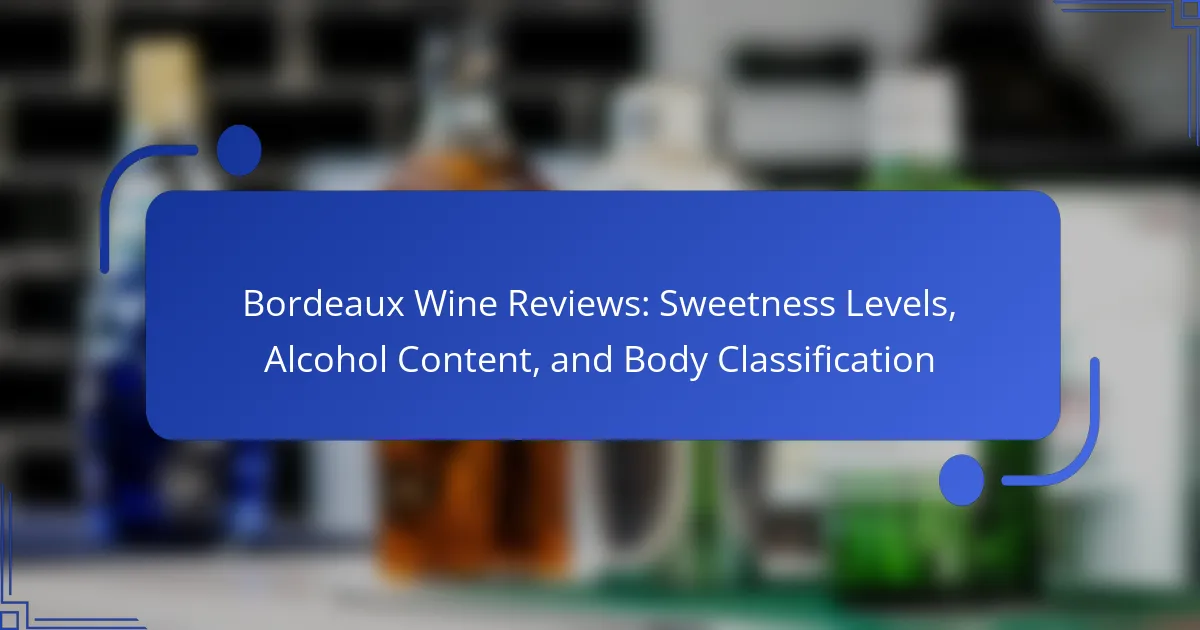
What are Bordeaux Wines?
Bordeaux wines are wines produced in the Bordeaux region of France. This region is renowned for its diverse grape varieties and unique terroir. Bordeaux wines predominantly feature blends of Cabernet Sauvignon, Merlot, and Cabernet Franc. The region’s climate and soil contribute to the distinct flavor profiles of these wines. Bordeaux wines can range from dry reds to sweet whites, such as Sauternes. The classification system in Bordeaux includes various designations, like AOC and Grand Cru. Bordeaux wines have a long history, dating back to Roman times. Today, they are among the most sought-after wines globally, with notable vintages fetching high prices at auctions.
How are Bordeaux Wines classified?
Bordeaux wines are classified primarily through the Bordeaux Wine Official Classification of 1855. This classification ranks wines based on their quality and reputation. The system categorizes wines into five growths, known as “crus.” The first growths are the highest quality, while the fifth growths are the lowest in prestige. The classification is based on historical sales prices and reflects the wines’ market value. Additionally, Bordeaux wines are also classified into categories such as AOC (Appellation d’Origine Contrôlée) and varietal classifications. AOC classifications ensure wines meet specific regional standards. These classifications help consumers identify quality and style in Bordeaux wines.
What are the key grape varieties used in Bordeaux Wines?
The key grape varieties used in Bordeaux wines are Cabernet Sauvignon, Merlot, and Cabernet Franc. Cabernet Sauvignon is known for its full-bodied flavor and aging potential. Merlot offers a softer, fruitier profile and is often blended with Cabernet Sauvignon. Cabernet Franc adds aromatic complexity and a lighter structure to blends. Other notable varieties include Petit Verdot, Malbec, and Carménère, which contribute to the region’s diverse wine styles. Bordeaux’s classification system highlights the importance of these varieties in creating high-quality wines.
How does the terroir influence Bordeaux Wines?
Terroir significantly influences Bordeaux wines by shaping their flavor profiles and characteristics. Terroir encompasses the soil, climate, and topography of the vineyard. Each of these elements affects grape growth and ripening. For instance, the gravelly soil of the Médoc region promotes excellent drainage, which benefits Cabernet Sauvignon. Additionally, the region’s maritime climate moderates temperatures, allowing for a longer growing season. This extended season enhances the development of complex flavors in the grapes. Studies indicate that variations in terroir lead to distinct wine expressions even from neighboring vineyards. For example, wines from Saint-Émilion often showcase different fruit characteristics compared to those from Pomerol due to their unique terroirs.
What are the sweetness levels in Bordeaux Wines?
Bordeaux wines have varying sweetness levels, categorized primarily as dry, semi-sweet, and sweet. Dry Bordeaux wines typically have less than 4 grams of residual sugar per liter. Semi-sweet Bordeaux wines, such as some Sauternes, can contain between 4 to 45 grams of residual sugar. Sweet Bordeaux wines, like those from the Sauternes region, can exceed 45 grams of residual sugar. These classifications are based on the fermentation process and the grapes used. The sweetness levels are influenced by factors such as grape ripeness and botrytis cinerea, a fungus that concentrates sugars.
What are the different categories of sweetness in Bordeaux Wines?
Bordeaux wines are categorized by sweetness levels into several distinct types. The main categories include dry, semi-dry, sweet, and very sweet wines. Dry Bordeaux wines, such as Bordeaux Rouge, typically contain less than 1 gram of residual sugar per liter. Semi-dry wines have a sweetness level between 1 to 5 grams of residual sugar per liter. Sweet Bordeaux wines, like Sauternes, contain 5 to 30 grams of residual sugar per liter. Very sweet wines can exceed 30 grams of residual sugar per liter. These categories highlight the diversity of sweetness in Bordeaux wines, influenced by grape variety and winemaking techniques.
How do sweetness levels affect the flavor profile of Bordeaux Wines?
Sweetness levels significantly influence the flavor profile of Bordeaux wines. Higher sweetness typically enhances fruity flavors, making them more pronounced. This results in notes of ripe berries, stone fruits, and tropical flavors. Conversely, lower sweetness levels often lead to more earthy and herbal notes. These wines may exhibit flavors like blackcurrant, tobacco, and leather. The balance between sweetness and acidity is crucial. It affects the wine’s overall mouthfeel and finish. Sweetness can also impact the perception of tannins. In sweeter wines, tannins may feel softer and less aggressive. Bordeaux wines with varying sweetness levels can cater to diverse palates. This diversity allows for a wide range of pairings with food.
What is the alcohol content of Bordeaux Wines?
The alcohol content of Bordeaux wines typically ranges from 12% to 15% ABV (alcohol by volume). This range is influenced by various factors, including grape variety and fermentation process. Bordeaux red wines generally have higher alcohol content, often reaching 13% to 15% ABV. White Bordeaux wines usually fall between 12% and 13.5% ABV. The climate of the Bordeaux region also contributes to the alcohol levels, as warmer temperatures can lead to higher sugar content in grapes, resulting in increased alcohol production during fermentation.
How is the alcohol content measured in Bordeaux Wines?
The alcohol content in Bordeaux wines is measured using the percentage of alcohol by volume (ABV). This measurement indicates the amount of alcohol present in a given volume of wine. Typically, ABV is determined through fermentation analysis. During fermentation, sugars in the grape juice convert to alcohol. The specific gravity of the wine is measured before and after fermentation. The difference in gravity indicates the amount of sugar converted to alcohol. The resulting ABV percentage is then calculated based on these measurements. Bordeaux wines usually have an ABV ranging from 12% to 15%. This range may vary depending on the grape variety and the winemaking process.
What factors influence the alcohol content in Bordeaux Wines?
The alcohol content in Bordeaux wines is influenced by several key factors. The primary factor is the sugar content in the grapes at harvest. Higher sugar levels lead to higher alcohol levels during fermentation. Climate conditions also play a significant role. Warmer climates typically produce riper grapes, which can enhance sugar accumulation.
The grape variety contributes to the alcohol content as well. Different varieties have varying potentials for sugar accumulation. Winemaking techniques, such as fermentation duration and temperature, can also affect the final alcohol level.
Lastly, the timing of the harvest impacts alcohol content. Late harvests often yield grapes with more sugar, resulting in higher alcohol levels. These factors together determine the overall alcohol content in Bordeaux wines.

How do sweetness levels impact Bordeaux Wine reviews?
Sweetness levels significantly impact Bordeaux Wine reviews. Wines with higher sweetness often receive higher ratings for their complexity and balance. Critics appreciate the integration of sweetness with acidity and tannins. This balance can enhance the overall flavor profile. Conversely, wines perceived as overly sweet may receive lower scores. Reviewers may describe them as cloying or unbalanced. The sweetness level is often indicated by the residual sugar content. For example, a wine with 10 grams of residual sugar per liter may be viewed more favorably than one with 30 grams. Overall, sweetness levels are a crucial factor in the assessment of Bordeaux wines.
Why is sweetness an important factor in wine tasting?
Sweetness is an important factor in wine tasting because it influences flavor balance and perception. Wines with higher sweetness can soften the acidity and tannins, creating a smoother taste experience. Sweetness also enhances fruit flavors, making the wine more appealing to many consumers. Additionally, sweetness levels can indicate the wine’s style and quality, especially in dessert wines. For example, Bordeaux wines can range from dry to sweet, with specific sweetness levels defining their classification. This classification affects food pairing, as sweeter wines often complement rich or spicy dishes. Thus, understanding sweetness helps tasters appreciate the complexity and character of the wine.
How do critics assess sweetness levels in Bordeaux Wine reviews?
Critics assess sweetness levels in Bordeaux wine reviews through sensory evaluation and analytical methods. They taste the wine to identify the presence of residual sugar. They also consider the wine’s balance with acidity and tannins. Critics often use a scoring system to quantify sweetness. Some reviews include specific sweetness descriptors like “dry,” “off-dry,” or “sweet.” Analytical tests may measure sugar content in grams per liter. This combination of tasting and analysis provides a comprehensive assessment of sweetness. Critics rely on established standards within the wine community for consistency.

What is the body classification of Bordeaux Wines?
Bordeaux wines are classified into three main body categories: light-bodied, medium-bodied, and full-bodied. Light-bodied Bordeaux wines are typically lower in alcohol and have a crisp, refreshing quality. Medium-bodied Bordeaux wines offer a balance of fruit and acidity, making them versatile for food pairings. Full-bodied Bordeaux wines are rich and robust, often featuring higher alcohol content and complex flavor profiles. This classification is based on the wine’s composition, including grape variety, alcohol level, and tannin structure. Bordeaux wines, particularly from regions like Médoc and Saint-Émilion, exemplify these body classifications.
How is the body of a Bordeaux Wine determined?
The body of a Bordeaux wine is determined by several factors. These include the grape variety used and the wine’s alcohol content. Full-bodied Bordeaux wines typically contain higher alcohol levels, often exceeding 13.5%. The concentration of sugars and tannins also plays a crucial role. Higher tannin levels contribute to a fuller mouthfeel. Additionally, the aging process can enhance the wine’s body. Wines aged in oak barrels develop more complexity and richness. The balance of acidity and sweetness further influences the perception of body. These elements combine to create the overall mouthfeel and texture of the wine.
What are the different body classifications for Bordeaux Wines?
Bordeaux wines are classified into three main body classifications: light, medium, and full-bodied. Light-bodied Bordeaux wines are characterized by lower alcohol content and higher acidity. These wines often feature delicate flavors and a refreshing quality. Medium-bodied Bordeaux wines strike a balance between light and full-bodied characteristics. They typically have moderate alcohol levels and a wider range of flavors. Full-bodied Bordeaux wines have higher alcohol content and rich, intense flavors. They often exhibit complex aromas and a robust mouthfeel. Each classification reflects the wine’s structure and taste profile, helping consumers choose according to their preferences.
How does body classification influence food pairing with Bordeaux Wines?
Body classification significantly influences food pairing with Bordeaux wines. Bordeaux wines are categorized into light, medium, and full-bodied classifications. Light-bodied Bordeaux wines pair well with lighter dishes such as seafood and salads. Medium-bodied Bordeaux wines complement poultry and pork dishes effectively. Full-bodied Bordeaux wines match robust flavors found in red meats and rich sauces. The body classification determines the wine’s weight and mouthfeel, which affects how it interacts with food. For instance, a full-bodied wine can enhance the flavors of a hearty dish without being overshadowed. The tannin structure in full-bodied wines also balances fatty foods, creating a harmonious pairing.
What are the common misconceptions about Bordeaux Wines?
Common misconceptions about Bordeaux wines include the belief that all Bordeaux wines are expensive. While some premium labels are costly, many affordable options exist. Another misconception is that Bordeaux wines are only red. Bordeaux produces white and rosé wines as well. Some think Bordeaux wines are always heavy and tannic. In reality, many Bordeaux wines have a lighter body and fruit-forward profiles. Additionally, people often believe that Bordeaux wines must be aged for many years. Many are enjoyable when young, depending on the style. Lastly, it is commonly thought that Bordeaux wines are overly complex. However, many are approachable and easy to understand, catering to various palates.
How can understanding sweetness levels and body classification enhance wine appreciation?
Understanding sweetness levels and body classification enhances wine appreciation by allowing consumers to identify their preferences. Sweetness levels indicate the residual sugar content in wine. Higher sweetness levels can appeal to those who enjoy sweeter flavors. Body classification refers to the weight and fullness of the wine on the palate. A full-bodied wine may provide a richer experience compared to a light-bodied wine.
By recognizing these attributes, wine enthusiasts can make more informed choices. For example, a dessert wine with high sweetness complements certain foods. Understanding body classification helps in pairing wine with meals based on texture. This knowledge leads to a more enjoyable tasting experience. Familiarity with these aspects can deepen appreciation for the complexity of wines.
What tips can enhance your Bordeaux Wine tasting experience?
To enhance your Bordeaux wine tasting experience, consider the following tips. First, choose the right glassware to maximize aroma and flavor. Bordeaux wines benefit from larger bowls that allow for better aeration. Second, serve the wine at the appropriate temperature. Red Bordeaux is best enjoyed between 60-65°F. Third, decant the wine before tasting. This process can improve the wine’s flavors and aromas by allowing it to breathe. Fourth, take note of the wine’s appearance. Observe its color and clarity to gain insight into its age and quality. Fifth, engage your sense of smell. Swirl the wine gently and inhale deeply to identify various aromas. Sixth, taste mindfully. Take small sips to appreciate the complexity of flavors. Finally, pair the wine with complementary foods. Classic pairings include red meats and aged cheeses, which can enhance the overall tasting experience.
Bordeaux wines, produced in the Bordeaux region of France, are renowned for their diverse grape varieties, including Cabernet Sauvignon, Merlot, and Cabernet Franc, and unique terroir that shapes their flavor profiles. The article explores the classification of Bordeaux wines, detailing the Bordeaux Wine Official Classification of 1855, sweetness levels ranging from dry to sweet, and body classifications of light, medium, and full-bodied. Additionally, it examines how factors like terroir, alcohol content, and sweetness levels influence wine reviews and tasting experiences, providing insights into common misconceptions and practical tips for enhancing Bordeaux wine appreciation.
